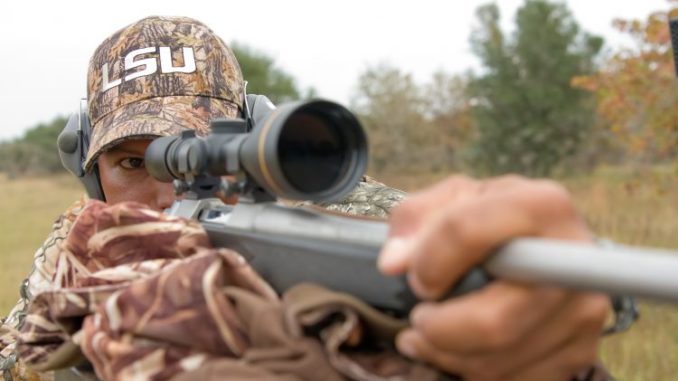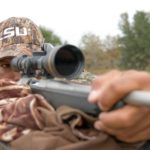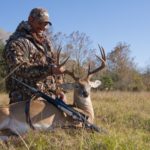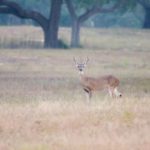
Ever wonder why that buddy of yours goes missing every January? It’s probably because he knows late-rutting bucks are cranking up and they are waiting in ambush. Here’s why you should get out there, too.
An old bass angler once told me he could tell what the fish were biting any time of year by looking at the empty pegs at his local tackle shop.
Assuming he could rummage around and find a few of the missing baits in his tackle box, he was confident he could get on some fish.
Whether there was actually something to his theory or he was the victim of a sneaky tackle shop owner, his advice made me wonder if there might be a way to tell what was going on by observing what — or who — was missing.
I became a student of observation any time I walked into a tackle shop. Then I started noticing certain folks seemed to take off work at certain times of the year.
Through fake coughs and imagined ailments upon their return, they told stories of how many fish they caught.
Years of silent observation finely tuned my senses and made me aware when people who wouldn’t normally miss a day of work suddenly weren’t at their desks.
But it’s not just work they miss: I started noticing a few years ago that one of the most faithful members of my church, who attends twice on Sunday and once on Wednesday, stopped coming to Sunday School during January.
However, he would show up for church services — sometimes.
Maybe the old bass angler was onto something, because here was a guy who never missed church suddenly being nowhere to be found.
Turns out this guy is about as avid a deer hunter as one can be.
I was talking to him about deer hunting after Sunday School just a few weeks ago, and learned something of his January absences.
“I haven’t even been,” he said. “I’m just not excited enough to go yet. It doesn’t really get good around here until January anyway, so I save all my energy for then.”
Bingo!
Looking back, I realized his January church-attendance pattern went something like this: Get up early and hunt through Sunday School, and if he didn’t see anything by then he would get down and head to church.
If the action was really good — or he scored a big buck — he missed church to either keep hunting or visit the skinning shed.
Well, here we are smack dab in the middle of another January, and I imagine if my fellow churchgoer were a deer I would have a pretty solid pattern on him.
Hunting during January means different things to different people, depending on what part of Louisiana they hunt.
In some parts of the state, the deer wrapped up the rut weeks ago. In other parts they are on the tail end.
But in the Florida Parishes, the rut is just getting started.
So if you hunt this area and are going to plan vacation time to hunt, this is the month to do it.
The best advice for any Florida Parishes hunter who has yet to score a buck is to make sure you’re sitting in the stand as much as possible this month.
“I’ve always said deer hunting around here is at its absolute best right when the season ends,” said Michael Williams. “These deer around here get to going in January, and I’ve seen bucks chasing does all the way through turkey season.
“There’s nothing wrong with hunting early in the season, but if you really want to have a bunch of fun, just wait until January.”
So that’s it: The big secret to being successful during the late part of deer season is to make sure you’re in the stand.
Well, there’s a little more to it than that.
Bucks could literally run does at any time of the day on any day of the week during January. That’s why January is the month of all-day sits in the Florida Parishes.
“I’ve probably seen more bucks up in the middle of the day than any other time around here during January,” Williams said. “But I’ve seen them from sunrise to sunset — you just never know.
“But if you don’t want to get up early, you can get in the stand mid-morning and sit until late afternoon.”
Hunting rutting bucks during the middle of the day takes a little more diligence than sitting over a corn pile during November. Because bucks are more interested in does than they are food, you might get only a split second to get off a shot.
Sitting in a stand with your phone in one hand and your rifle in the other just won’t cut it. By the time you see him, put your phone down and raise your rifle, the deer likely will be gone.
“Pay attention the entire time you’re in the stand,” Williams advised.
That means hunting the most comfortable stands you can find and dressing as comfortably as possible for the weather conditions is paramount. It’s hard to intently watch for bucks if you’re constantly worrying about your aching back or focused on frozen feet.
“Whatever you’ve got to do to help you stay out there longer, do it,” Williams said.
Although many stick with hunting food plots at the end of the season, that might not be the best way to score a big buck.
Definitely take your food plots into consideration, but do not set up directly over them. Instead, back off the downwind side of the plot and set up so you can see patrolling bucks scent-checking for does.
“That’s a great way to hunt around here during the rut,” Bob Watson said. “And the problem with the way some hunt is they put themselves on the south end of the plot because of the north wind, and the bucks will smell them while they’re checking for does.”
Rather, Watson suggested setting up in the woods kind of to the side to the east or west to get a clear shot at a buck looking for does from directly downwind.
“Of course, you’ve got to take what you can get,” he added. “Just getting back in the woods on the downwind side will give you a better chance of seeing a buck during shooting hours than sitting smack dab on the edge of your plot.”
While some hunters might confine themselves to small zones where they would not even be able to see a deer until it was within 30 or 40 yards, others prefer to sit on the edges of large clear cuts where they can see deer activity for several hundred yards.
When bucks are chasing, there might not be any better way to hunt than that latter scenario because it offers of the opportunity to see and shoot bucks from a great distance.
Bucks that had been hesitant to step out until dark only weeks ago now don’t mind showing themselves right in the middle of the day.
“The key is to keep a close eye on your does,” Williams said. “If you’re watching a pile of does, pay attention to how they’re behaving. Most of the time during January around here, they’ll be kind of nervous, looking like they’re expecting something to jump out of the thicket.”
Watching does could also come into play whenever you see one through your hunting spot rather quickly. Odds are she is on the move to stay in front of a chasing buck.
But it doesn’t matter whether they’re nervously watching the thickets or actively on the move, hunters need to pay close attention to what’s coming next.
Both behaviors indicate a chasing buck could be near by, so this is not the time to let down your guard and pick up your phone. That trophy buck might be just seconds from making its appearance, or he could be several minutes away.
And if you choose to shoot the doe, don’t immediately abandon your stand and go pick it up.
My nephew Zack learned that the right way last season.
He was hunting with his girlfriend Faith, and she had just dropped a doe. They were getting out of the ground blind to go retrieve her deer when Zach spotted a buck stepping out of the nearby thicket.
The buck was only worried about finding the doe, so Zach had time to lift his rifle and shot the buck — mere moments after Faith had put down the doe.
If you can’t hunt an open area like a clear cut, Franklinton hunter Joey Roberts suggested finding a spot that allows you to hear approaching deer.
“Pine plantations are the worst because everything is so quiet on those pine needles,” Roberts said. “I want something like an open bottom with a little water in it or a spot with lots of dry leaves.
“Around here, if you’re not in a clear cut you better be able to hear them coming or they’ll be right on top of you before you know it.”
And, although it’s too late to put this tip into action for this year, one thing you can shoot for next season is to allow deer a sanctuary on your land that allows them to feel completely comfortable and at ease during most of the season.
Only during the rut would you slip in and hunt it. And once you kill one get out.
“I want my best spot undisturbed for three-quarters of the season,” Roberts said. “I don’t go in until the rut, and I don’t let anybody else in, either. And once I get one, which usually happens the first couple of hunts, I get out and hunt someplace else until the season is over.
“This gives these deer an undisturbed place to live all year long, except for those first few days of the rut.”
And one last late-season tip that might work to your favor is to hunt trail intersections.
Rather than sitting on the side of a single trail, do a little homework and walk deer trails until you find where multiple paths intersect.
More often than not, you’ll walk a main trail until you find a spot where that one trail breaks off into a few different trails heading off into different directions. Since bucks will be on the move during January, climbing a tree at an intersection like this is a dynamite way to spot a big buck no matter which direction it comes from.
That’s where having a climbing stand comes in handy.
We love hunting ground blinds at my property, and they’re pretty mobile because we can break them down and put them back up someplace else.
However, in the case of one trail intersection we found a few years ago, the general surroundings were too thick to effectively deploy a ground blind. Rather than completely dismiss the spot, we stuck a climbing stand on the downwind corner of the intersection and saw deer just about ever time we hunted it.
So if you know any grizzled deer hunters around where you live, start paying attention to when they stop showing up at places where you regularly see them.
Chances are, their absence means something else is going on to attract their attention.
If they go missing in January, you can bet they’re sitting in deer stands because deer are on the move.
Take the hint and get in your own stand. That’s the No. 1 way to successful late in the season — get in the woods and stay there.




